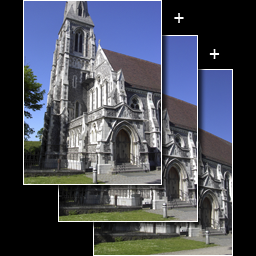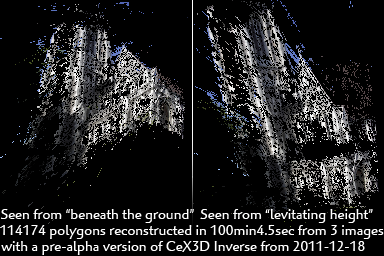CeX3D Inverse is Hardcore Processing's upcoming new product, a computer program for constructing digital 3D models from ordinary camera images automatically.
For the first time, we are now showing pictures of an actual fully automatically generated 3D model:


The generated model is shown from two different angles: from "beneath the ground" and from "so high up that the photographer couldn't possibly have jumped that high". The model consists of slightly more than 100,000 polygons (trigons) and was generated automatically in about 100 minutes from three 4M pixel (2048x1536) images without any prior or manual camera calibration. The 3D model still contains holes with missing polygons as well as wrongly or noisily reconstructed polygons. However, we are seeing improvements in quality more or less weekly and we believe that this trend will continue for a while.
Some time ago,
CeX3D Inverse's critical TODO-list before alpha release (click here)
became available. Two more points on that list are now complete,
along with several other improvements, as described below.
Point Three
As witnessed by the above pictures, CeX3D Inverse's 3D
reconstruction now works and is able to generate 3D models.
Along with this change, several improvements were
also made to some parts of CeX3D Inverse. This turned out to be
necessary, in order to achieve a level of quality that is presentable.
This required a substantial amount of work
and has therefore taken quite a while to develop.
Point Five
Two parts of CeX3D Inverse were previously quite slow.
This has been remedied to some extent by now: the 3D model shown above
was generated in around 100 minutes, which is starting to be reasonable,
especially since this is when using only one CPU core and no
graphics card (GPU) acceleration.
One reason that it still takes fairly long is that the necessary
improvements mentioned earlier has introduced additional computation
that also take time. Apart from this, several parts
of CeX3D Inverse could still be optimized, even without a huge amount of work.
Finally, when we start to use multiple CPU cores (though this will not
be in the first alpha-releases), some factor of speed-up can easily
be achieved for at least some of the parts of CeX3D Inverse; other parts
will be harder to get to exploit multiple CPU cores.
In short, you can expect several speed-improvements later on.
The Work Continues
We are continuing development of CeX3D Inverse. The last three remaining points on CeX3D Inverse's critical TODO-list before alpha release (click here) should take less time to complete than it has taken to complete the other four points. The completed points were challenging problems, while the remaining three are simpler and more predictable to solve. We are expecting the first alpha release to be ready some time in January or early February.
Follow the news page (click here) to see the latest status and achievements.
![]() Modified: 2015-04-12
Modified: 2015-04-12
E-mail: Contact